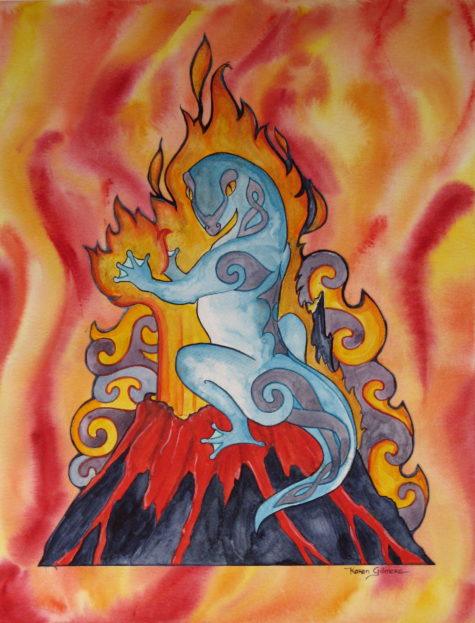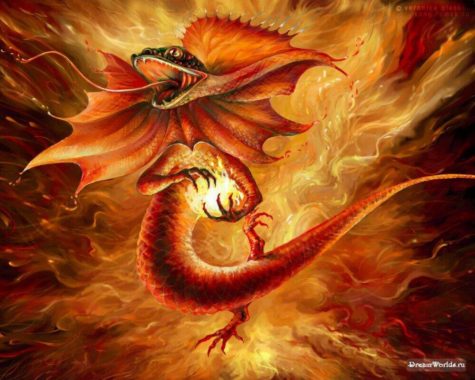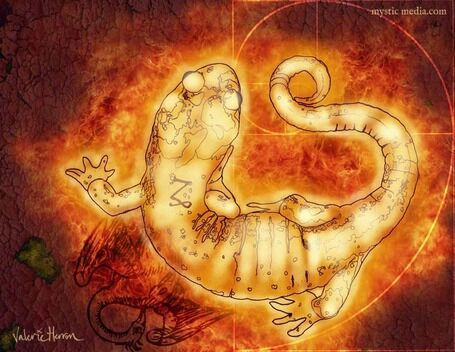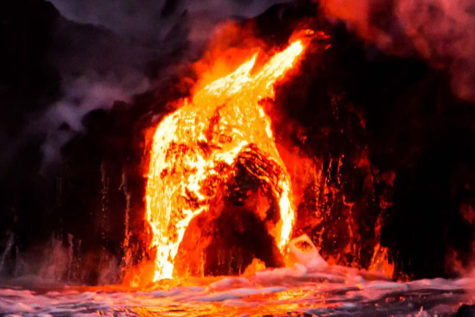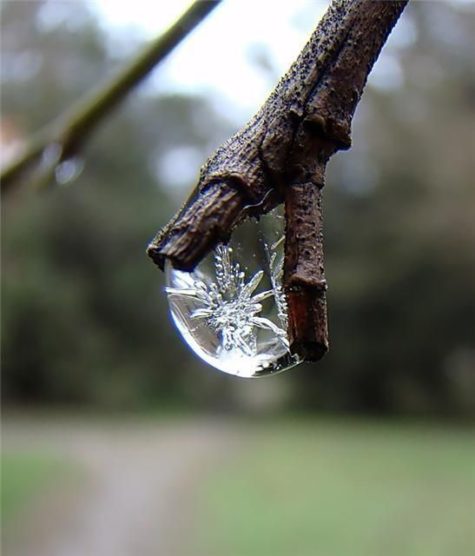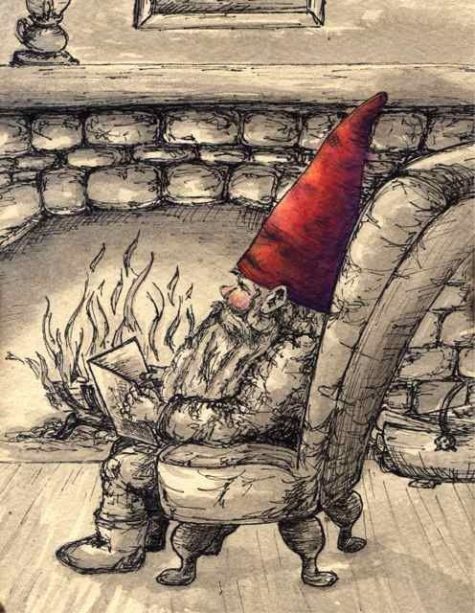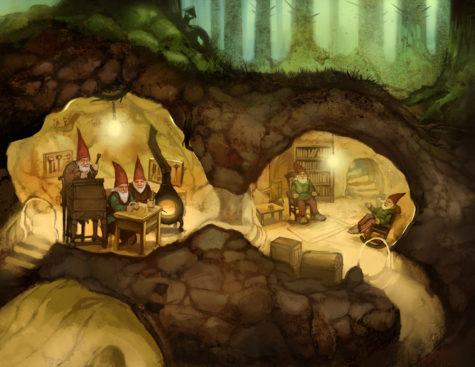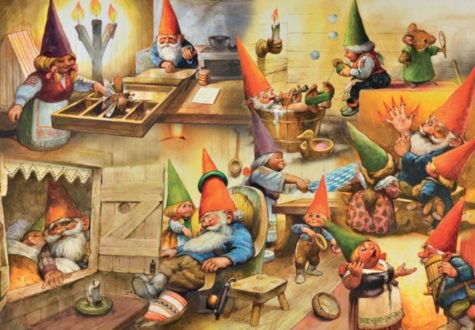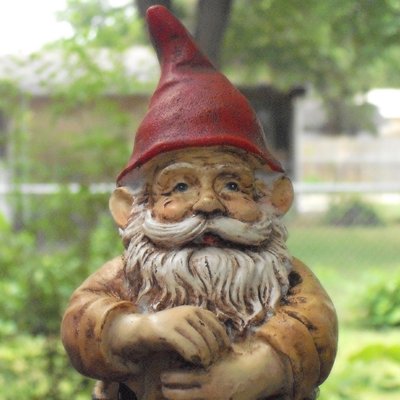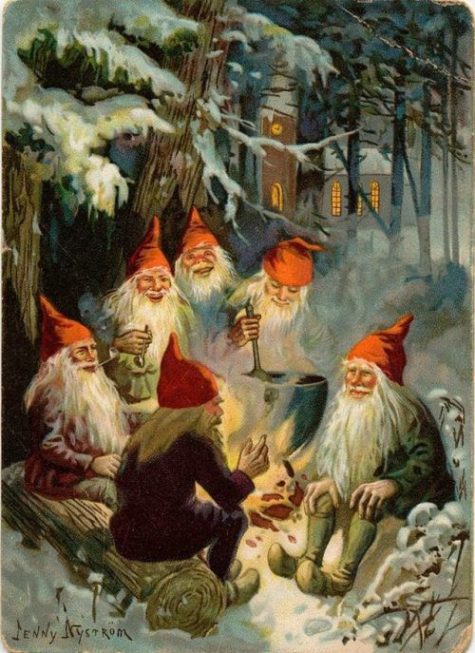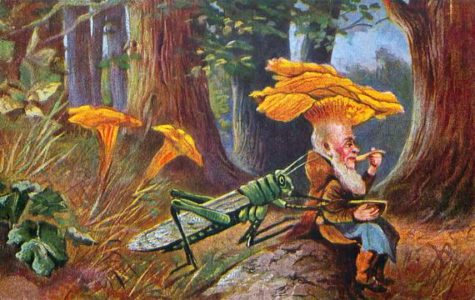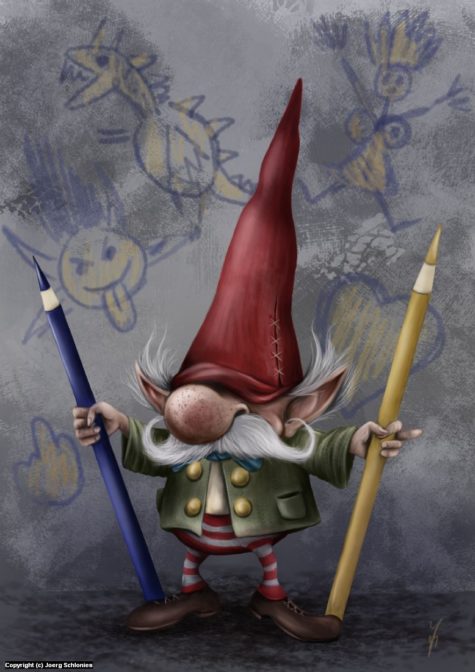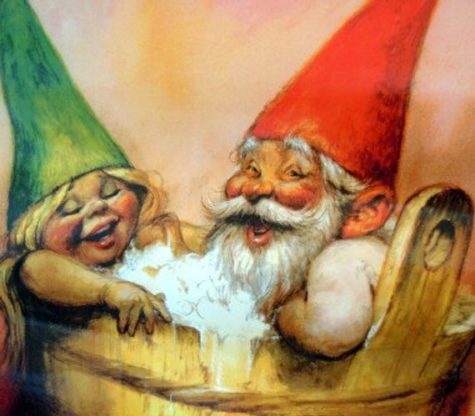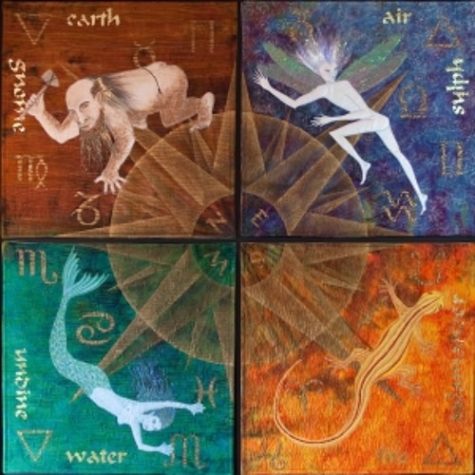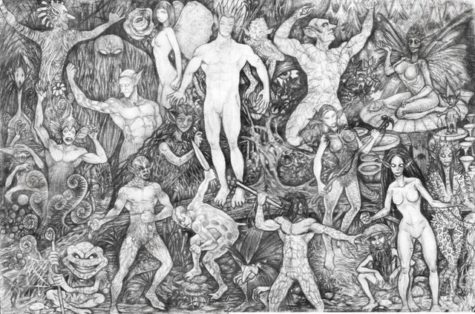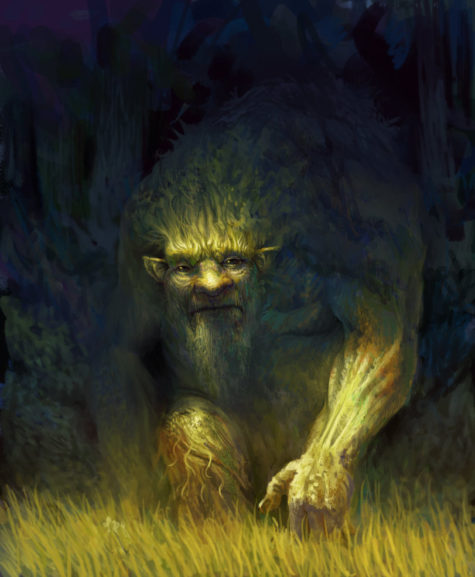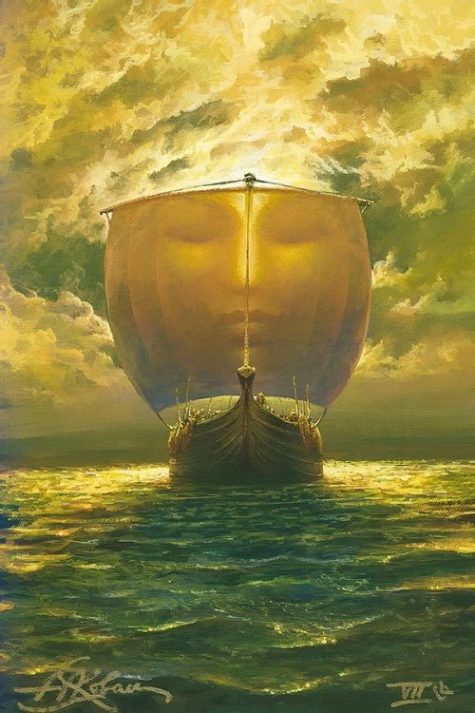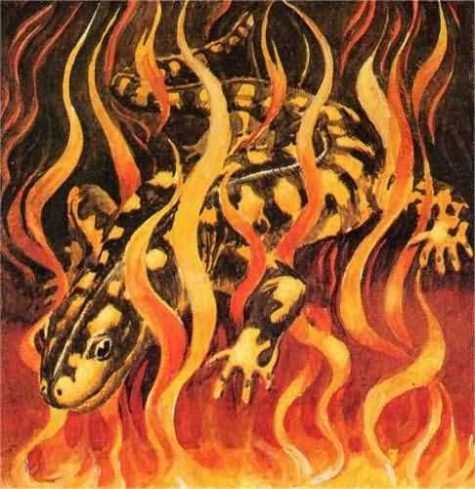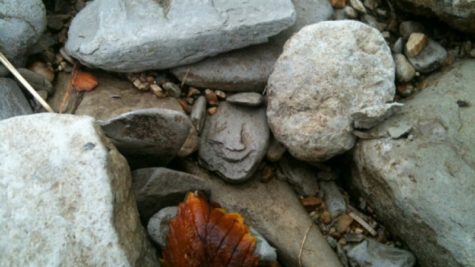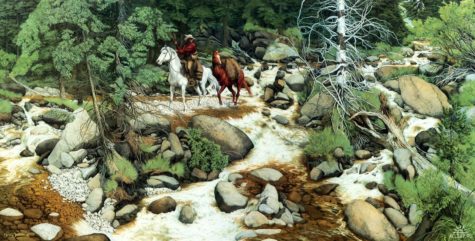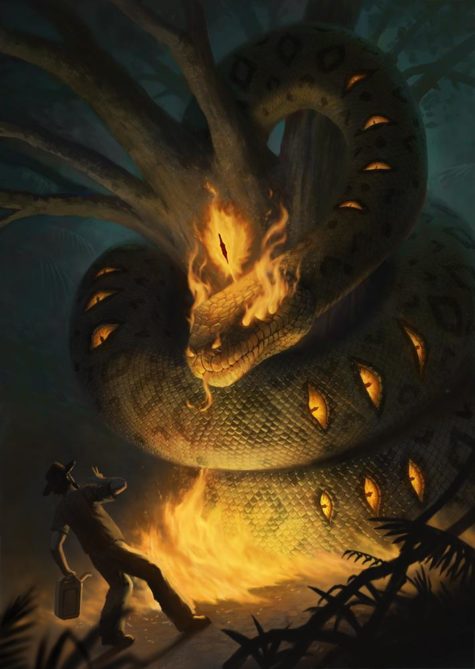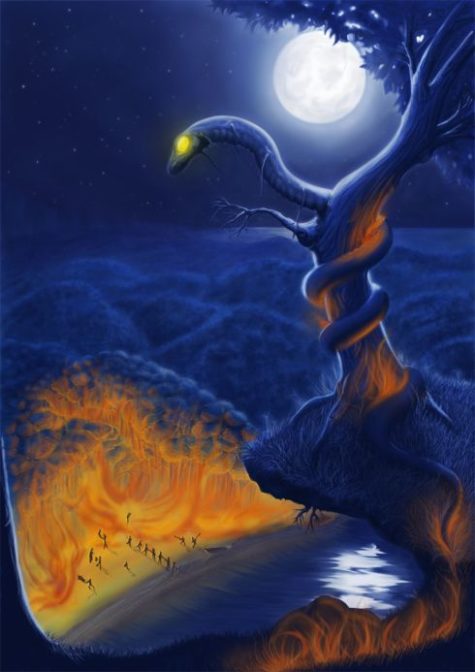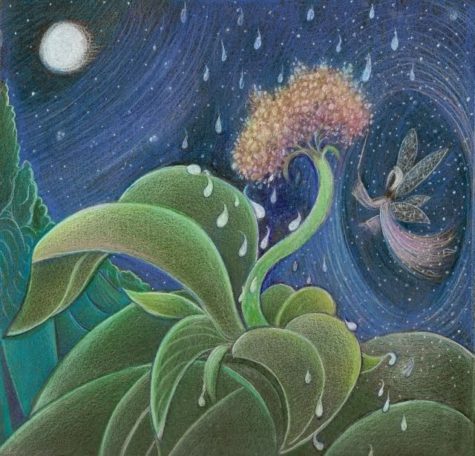Nature Spirits
“Be lit by the fires of life. They are transforming.
Nothing touched by fire ever remains the same.”
~Avia
- Element: Fire
- Direction: South
- Form: Lizard-like
- Heraldic signification: A brave and generous courage that the fire of affliction cannot destroy or consume.
- Key words: Wild, Bold, Sultry, Feisty, Lively, Energizing, Impetuous, Passionate, Consuming, Enlightening, Illuminating, Commanding
The elemental concept of, and the term salamander was coined by Paracelsus, a highly respected physician of the 16th century. They are fabled to have taught ancient man how to create and use fire.
The Salamanders are the elemental guardians of fire, they are here to control and contain flames. Fire is one of the most destructive elements on the planet and it is their job to ensure the planet safety from it. Salamanders also know how to use the destructive force of fire for good. Fire energy allows for renewal and regrowth. Every flame and fire has a guardian Salamander present. Anytime you are struggling to light a fire call upon the Salamanders to help.
The fiery elemental Salamander is no real relation to the amphibious salamander. Although, amphibian salamanders do live in moist logs and villagers of days gone by observed throwing logs on a fire caused salamanders to scurry out from the logs. For this reason, some of our more naive ancestors thought fire was the birth-giver of the salamander, and here we find a lore-connection to our fire elemental salamander.
Fiery Salamander Energy
Salamanders are not the lizards we see running around, they are found in the flames of a fire. They are darting, dancing and ever changing. Salamanders are associated with all things that have to do with heat and fire.
Salamanders are Elementals to be respected and possibly even feared. Think of how temperamental fire is: It erupts and destroys, it rages, it ravages. You do not want to be in the path of a rampaging Salamander! But, like the phoenix, this destruction brings rebirth. It allows us to start again. Salamanders purify by banishing the old and allowing the new to come to light, using the flame of the Sun to nurture growth.
The detoxification shows up in our bodies as well. When we are sick and run a fever, that is the Salamander energy burning off toxins. Salamander elementals also oversee the heat in our bodies, aka our metabolism. They set the regulator for how we ‘burn’ calories. Low fire means low energy, a slow metabolism and sluggishness. Without fire in our bodies we feel fatigue, lethargy, a lack of creativity, we lose the ability to concentrate and lose interest in sex (again, a creating energy).
As witches we will use a flame to signify burning negative energies and then we bury the ashes in the earth, cast them to the wind or run them under water – but it is the fire that destroys.
There are some essential oils and incenses that can help us conjure up the heat energy, my favorite is dragon’s blood, but you can use frankincense, patchouli, mugwork, heliochrysum, and of course sage. Herbs that help are cinnamon, peppermint, ginger, nutmeg, rosemary, and of course, pepper.
When we are healthy and the Salamander energy is flowing we feel confident, we are assertive, and vital. Too much Salamander and we get aggressive, rageful, arrogant and vain. To counteract this use herbs that ground or dampen.
Salamander Myth and Lore
Salamanders have long held a significant place in the folklore and mythology of many different countries around the world. Fantastic powers and attributes have been bestowed upon them giving them a place in mythology, alchemy, heraldry and popular culture that is perhaps surprising, for what in reality is a rather small, humble creature.
The lore continues to weave in and out of collective imagination as we learn elemental Salamanders were attributed for the presence of coronas or points of discharge. Commonly known as St. Elmo’s Fire, salamanders were thought to produce electric fields of energy, and sometimes great glowing orbs of fire.
Other ancient accounts tell of fire elementals living in volcanoes. Dormant volcano’s indicate contented, slumbering salamanders. When erupting, the salamanders’ wrath has been incurred, and their lava tongues come to lick up everything in their path.
The salamander is mentioned in the Talmud as a creature that is a product of fire, and it relates that anyone who is smeared with its blood will be immune to harm from fire. Rashi (1040–1105), the primary commentator on the Talmud, describes the salamander as one which is produced by burning a fire in the same place for seven years.
Saint Augustine in the City of God used the example of salamanders to argue for the possibility of humans being punished by being burned in eternal flame in Purgatory. He wrote “If, therefore, the salamander lives in fire, as naturalists have recorded, and if certain famous mountains of Sicily have been continually on fire from the remotest antiquity until now, and yet remain entire, these are sufficiently convincing examples that everything which burns is not consumed.”
Leonardo da Vinci (1452–1519) wrote the following on the salamander: “This has no digestive organs, and gets no food but from the fire, in which it constantly renews its scaly skin. The salamander, which renews its scaly skin in the fire,—for virtue.”
Pliny describes it as “a sort of lizard which seeks the hottest fire to breed in, but quenches it with the extreme frigidity of its body.” He tells us he tried the experiment once, but the creature was soon reduced to powder. *There was also a belief that the skin and other parts and extracts of the salamander gave protection against fire.
Early travelers to China claimed they had had been shown clothing reputedly woven from salamander hair that had been deliberately placed in a fire and came out unscathed. Today many people think that they were shown clothing made from asbestos fibers.
The salamander of mediæval superstition was a creature in the shape of a man, which lived in fire (Greek, salambeander, chimney-man), meaning a man that lives in a chimney. It was described by the ancients as bred by fire and existing in flames, an element which must inevitably prove destructive of life.
Gregory of Nazianzen says that the salamander not only lived in and delighted in flames, but extinguished fire. St. Epiphanius compares the virtues of the hyacinth and the salamander. The hyacinth, he states, is unaffected by fire, and will even extinguish it as the salamander does. “The salamander and the hyacinth were symbols of enduring faith, which triumphs over the ardor of the passions. Submitted to fire the hyacinth is discolored and becomes white. “We may here perceive,” says M. Portal, “a symbol of enduring and triumphant faith.”
The Poisonous Salamander Of Myth
The salamander was also reputed to be so toxic that if it entwined itself around a fruit tree then the fruits become poisonous to all who would eat them. The saliva was thought to cause the hair of a person to fall from the body if it made contact with human skin.
If a salamander got into a well then the well water would be poisoned and undrinkable. Many species of salamanders do secrete a toxic substance from their bodies when threatened but the toxicity of the substance was greatly exaggerated.
The salamander is found throughout French folklore, although in differing form. In addition or sometimes instead of its fire symbolism, it was attributed a powerful poison. Some legends say that merely by falling into a well, it would poison the water, and by climbing a fruit tree, poison the fruit. Its highly toxic breath was reportedly enough to swell a person until their skin broke; in Auvergne, it supposedly did the same to herds of cattle. This gained it the name of “bellows breath”.
Like the real animal, the legendary salamander breathed seldom; unlike the real salamander, the only way to kill one was said to be to lock it in a confined space so that it breathed its own poison. The Bretons feared it so they did not dare say its real name for fear it would hear and then kill them.
Channeled Message from the Salamanders
“We are the elementals of fire and come forward to bring through our wisdom for you at this time. We beings of fire bring forth the creative energies and the energies of transformation and change. Planet earth is evolving in more ways than one and at this time humanity has a choice whether to stagnate as a race or utilize the available cosmic energies and frequencies that the planet is being bathed with. We salamanders offer our wisdom to those who wish to embrace the new life opportunities presented. We are creators and utilizing the element of fire within you will allow you to move out of stagnation and into action and creativity. Call upon the salamander energy when you are manifesting and when you feel sluggish and stuck. We dance with delight within the flames and offer your soul the opportunity to dance with us.”
Sources:
Undines are water elementals, and as such, spirits of the water world. First named in the alchemical writings of Paracelsus. Undines are almost invariably depicted as being female. They are said to protect our water. As a water elemental, the Undines’ domain are the oceans, seas, rivers, lakes, ponds, water and all it encompasses. There are theories that say undines are present in every drop of water. We could say an Undine is a personification of water, that they are the energies of water. Many schools of thought liken Undines to sprites, nymphs and mermaids.
There are many groups of undines. Some inhabit waterfalls, where they can be seen in the spray; others are indigenous to swiftly moving rivers; some have their habitat in dripping, oozing fens or marshes; while other groups dwell in clear mountain lakes. According to the philosophers of antiquity, every fountain had its nymph; every ocean wave its oceanid. The water spirits were known under such names as oreades, nereides, limoniades, naiades, water sprites, sea maids, mermaids, and potamides. Often the water nymphs derived their names from the streams, lakes, or seas in which they dwelt.
In describing them, the ancients agreed on certain salient features. In general, nearly all the undines closely resembled human beings in appearance and size, though the ones inhabiting small streams and fountains were of correspondingly lesser proportions. It was believed that these water spirits were occasionally capable of assuming the appearance of normal human beings and actually associating with men and women.
There are many legends about these spirits and their adoption by the families of fishermen, but in nearly every case the undines heard the call of the waters and returned to the realm of Neptune, the King of the Sea.
Practically nothing is known concerning the male undines. The water spirits did not establish homes in the same way that the gnomes did, but lived in coral caves under the ocean or among the reeds growing on the banks of rivers or the shores of lakes.
Among the Celts there is a legend to the effect that Ireland was peopled, before the coming of its present inhabitants, by a strange race of semi-divine creatures; with the coming of the modem Celts they retired into the marshes and fens, where they remain even to this day. Diminutive undines lived under lily pads and in little houses of moss sprayed by waterfalls.
The undines worked with the vital essences and liquids in plants, animals, and human beings, and were present in everything containing water. When seen, the undines generally resembled the goddesses of Greek statuary. They rose from the water draped in mist and could not exist very long apart from it.
There are many families of undines, each with its peculiar limitations, it is impossible to consider them here in detail. Their ruler, Necksa, they love and honor, and serve untiringly. Their temperament is said to be vital, and to them has been given as their throne the western corner of creation.
They are rather emotional beings, friendly to human life and fond of serving mankind. They are sometimes pictured riding on dolphins or other great fish and seem to have a special love of flowers and plants, which they serve almost as devotedly and intelligently as the gnomes. Ancient poets have said that the songs of the undines were heard in the West Wind and that their lives were consecrated to the beautifying of the material earth.”
In medieval times the conjuration and exorcism of elementary spirits was practiced extensively, the crystal being a preferred mean of evoking them. In every instance, a special consecration of the four elements was a principal and essential part of the ceremonial procedures.
Undine origins may be best traced back to ancient Greece wherein mythology cites a clan of nymphs called Oceanides who claimed the waters of the world as their home. These beings were the daughters of Titan and his wife Tethys. Their presence in the oceans was legendary among seafarers. Mostly beneficent, Oceanides would aid water-travelers in navigation and provide safe sea-ways.
A Short Summary:
- The term Undine comes from the Latin root unda which means “wave.”
- As they are entities united with water, Undines are governed by the Moon.
- Undines are also associated with the directional domain of the West.
- As water lovers, Undines will speak most freely to water signs (Cancer, Pisces, and Scorpio)
- The realm of cups in the Tarot are connected to Undines and study of this Tarot suit may augment our concept of their temperament.
In European lore, Undines are fabled to be the wandering spirits of love-lorn women. I imagine their tears of sorrow composed the salty seas as they wept, having lost at love. Tales indicate these female spirits are enchantingly beautiful. They are reputed to be relatively benign, but like any decent spirit they’ve got a temper when crossed.
Undines, (like their elemental kin: Salamanders, Sylphs and Gnomes) unite within their medium to form a impenetrable energetic bond. Thusly, nature-based belief systems may pay homage to the Undine as the embodiment of water itself. When we hear the term “Guardians of the Watchtowers” Undines would be the guardians of the water, and so communication in this arena would be directed to their kind.
A German Folktale
The undine, or undine-like creatures, are not limited to just one mythology. They are found in Greek, Irish, Scottish, Russian, Norse, and German stories.
Although resembling humans in form, they lack a human soul, so to achieve immortality they must acquire one by marrying a human. Such a union is not without risk for the man, because if he is unfaithful, then he is fated to die.
One German folktale tells the story of a young man who is caught in a storm and seeking shelter. He finds the cottage of a sweet elderly couple who live by the river. They have a beautiful daughter who is wild and tempestuous — and incredibly enticing for this young man. She is an Undine, though the human man does not yet know it, and her elderly father is King of the Watery Realm.
The old man gives the traveler permission to marry his daughter and take her to his kingdom, but on the condition that he treat her well. Should he forget that promise, he would lose his wife forever.
They marry and the Undine gives birth to a son soon thereafter. Now in possession of a human soul, the nymph loses her wildness and becomes a demure, polite housewife — which, in turn, causes her husband to be bored of her. Not even her devastating beauty keeps her husband from straying.
Once her husband betrays her, the Undine returns to her watery kingdom and warns him that if he should ever fall asleep, she would steal his breath. And of course, unable to stay awake, the man ultimately pays for cheating.
There are many different versions of this story, some of which have made their way to operas, novels, and films.
Something To Think About
“We never know the worth of water till the well is dry.”
~Thomas Fuller
I’m of a mind to say these beings intertwine their energy in mass to actually produce the element of water. Just as molecules cling and weave together to form bodies of mass – so too might the Undines unite their energies in a grand matrix that IS water.
Would that mean when we drink a glass of water, we are actually consuming Undines? Would we be more aware and honorable in our use of water if we knew we were interacting with beings possessing real feelings, thoughts and human-like aspects? I don’t know, but it’s something to consider.
Indeed, when these concepts came to me, I became more mindful about water and my consumption of it. This perspective put an actual face on water. Water ceased to be some object at my disposal. Rather, water became a community of personalities and intelligence to which my respect is due.
Give this thought process a try for yourself. Consider your interaction with water as you would interact with a close friend. Doing this really opened up floodgates of tremendous insights and poignant discoveries for me. I wonder if you will have similar experiences of psychic cleansing and breakthrough.
A resource for your consideration as you swim in the energy of the Undine might be Masaru Emoto’s book, The Hidden Messages in Water. Emoto’s research visually captured the structure of water at the moment of freezing, and through high-speed photography he shows the direct consequences of destructive thoughts and the thoughts of love and appreciation of the formation of water crystals. The revelation that our thoughts can influence water has profound implications for our health and the well-being of the planet.
Masaru Emoto contends (and indeed, has evidence) that water responds to external influence such as human suggestion. His research supports the idea of personality and intelligence indwelling water.
- Are Undines responding to suggestion?
- Are they the ones behind the scenes creating those magnificent crystal formations Mr. Emoto has captured on film? You be the judge.
Sources:
- Origin: Teutonic
- Emblem: Mushrooms, especially fly agaric or fly amanita
- Plant: The presence of galbanum (freula galbaniflua) allegedly invites the protection of gnomes.
- Iconography: The standard garden gnome depicts an older male with a long beard and peaked red hat. He wears a big belt over leggings, a blue tunic, and boots. Sometimes they wear gardeners’ aprons.
The name “gnome” stems from the Greek word “genomos” which means “earth dweller”. They are said to be one of the elemental spirits defined by Paracelsus, as representative of the Earth Element.
Gnomes are subterranean spirits now most associated with garden statuary. They resemble tiny people. Paracelsus described gnomes as two spans high. (A span is the width of an outstretched human hand,) Unlike dwarves or kobolds, gnomes are not mine or cave spirits but tend to live beneath human gardens. They have a reputation for emerging at night to do a little helpful garden work. Garden gnomes allegedly bring luck.
Gnomes tend to be quiet, private, taciturn spirits, but they respond well to gifts and offerings. They can be persuaded to become loyal allies, guardians, and helpers. Female gnomes may be especially taciturn; they are rarely depicted. However folklore indicates that their are entire gnome communities with male and female gnomes of all ages. Gnomes maintain good relationships with birds, rabbits, foxes, hedgehogs, and squirrels.
Originally, gnomes were thought to provide protection, especially of buried treasure and minerals in the ground. Gnomes were regarded as good luck charms by our ancestors and would often be found living in the rafters of barns where they would help watch over livestock. They are still used today.
Garden Gnomes vs “Actual” Gnomes
Modern garden gnomes are based on the legendary “Gnomes” of myth, mysticism, and fairy tales. Gnomes have historically been described as small (from a few inches to a foot or two in height) stout beings who live in Nature – usually underground. European magicians and other mystics considered gnomes the most common and important elemental spirits of the ‘Earth’ element (the other three classical elements being: ‘Water,’ ‘Fire,’ and ‘Air’).
Gnomes were said to wear conical hats and to be able to move through the earth itself as easily as we humans walk upon it, yet if any of these underground dwellers were caught out in the daylight it was said that the rays of the Sun turned them into stone.
Sometimes gnomes were said to have magical powers to protect or punish people – or to reward them with happiness. Gnomes are also said to be guardians of secret underground treasures – especially gold! Even in modern times gnomes are said by some –such as the highly influential mystic Rudolph Steiner – to be involved in the hidden processes of plant life. In fact many farms, including prize-winning wineries, follow principles based on these beliefs.
Garden Gnomes Today
More modern descriptions of gnomes usually emphasize their bright red pointed hats, solid colored clothes, and the long white beard of the typical male. Though sightings of female gnomes are rarely reported, gnome women are generally thought to be beard-free.
The name ‘gnome’ is said to come from the Latin word ‘gnomus’ which is thought to possibly come from the Greek word ‘gnosis’ meaning “knowledge” (i.e. of hidden treasure), but is more likely rooted in the word ‘genomos’ meaning “earth dweller”
A garden gnome adds a bit of whimsy and a connection to the old world, where farmers believed the good luck charm could help their fields yield more produce and protect them from thieves, pests and other problems. They were also thought to help gardeners in the night, which we all could use!
The earliest gnome statuary was produced in Thuringia, Germany, in the early nineteenth century and was based on German folklore. Gnome statues potentially welcome and attract real gnomes, as well as Flower Fairies or other benevolent spirits. The earliest statues were carefully wrought, hand-painted terra-cotta and were exceptionally popular.
By the 1960’s, cheaper plastic and resin versions were mass-produced. The old terra-cotta ones are now extremely valuable and are family heirlooms. Garden gnome statues tend to evoke very visceral responses. Some people adore and collect them. Others loathe them so much that they feel justified destroying or removing other people’s property.
Gnomes are the subject of modern entertainment as well as old folktales. The animated children’s television show The World of David the Gnome was highly unusual in that it depicted both male and female gnomes. The gnomes in J. K. Rowling’s Harry Potter series are garden pests, not helpers.
Some Handy Garden Gnome Trivia:
- Gnomes are banned from the Royal Horticultural Society Chelsea Flower Show. We think that’s a crying shame, personally.
- There are three categories of mass-produced gnomes: Worker gnomes, who always carry tools like fishing rods, shovels, or hammers; at-ease gnomes who typically carry a pipe and cultural gnomes who have a musical instrument in hand. Rock stars.
- Gnomes have a life expectancy of 400 years.
- Their main enemies? Mean humans who destroy the environment and trolls – obviously.
- Male gnomes always wear red caps.
- The world’s oldest garden gnome, called Lampy, has been living at Lamport Hall in the UK for 125 years and is worth a cool £2 million, or €2.4m!
- In the 1980s, the Gnome Liberation Front stole gnomes and sent the owners photos of them from landmarks around the globe.
- Gnomes are generally vegetarian and eat foods like nuts, mushrooms, peas, beans, potatoes, applesauce, fruit, berries, tubers, spices, vegetables, and preserves for dessert.
- They like to drink mead dew made from fermented honey, fermented raspberries, and spiced gin as a nightcap.
- Gnomes kiss by rubbing noses. They also use nose rubbing as a greeting equivalent to human handshaking.
Forest Gnomes:
There are gnomes that live in the forest in the Philippines. You can tell where they live if there’s a hill of dirt that’s a bit higher than everything else. And when you go by them, you’re supposed to be really, really respectful and say:
“Excuse me. I’m just walking by. I don’t mean any harm.”
Even if you’re not doing anything, or no one said anything, or you’re not sure. You’re just supposed to do it. If you don’t, there could be blow back as per the following:
“There was a story on the Philippines news channel, about a kid who had huge swollen lips. You could hardly see his eyes. He was speaking to reporters and he said that he was walking by the hills and his friend told him that you’re supposed to say sorry and he said, “No, I’m not. I don’t care. I don’t believe in that stuff.”
Then the next day he woke up with a tumor on his face. Not so much as a tumor, but as his lips were super swollen. It looked like someone blasted air into his lips. Like super Botox.”
Walking Gnomes
The following story is very interesting in the fact that this is one of the few stories from Mexico where inanimate objects, that are not haunted, come to life. The Mexican culture does not traditionally include creatures such as gnomes but instead, it consist of larger creatures and ghosts. This is because the country did not originally have gnomes until places, such as the United States introduced them to there.
“In Mexico they believe that garden gnomes come alive at night. The proof they have of it is that my grandma used to own gnomes and her neighbors used to own gnomes in Mexico. And the garden gnomes the next day would be found in different places and a lot of stuff was broken and sometimes my mom and her sister would wake up at night, and they would hear things, but when they looked outside, they would never see the gnomes there. So there’s that story that they become alive at night in Mexico.”
“Recently I was talking to one of my cousins who told that story to some friends whose parents were also from Mexico. And this friend told my cousin that he actually believes that story, because one night the garden gnomes were not where they had placed them. They found them inside the house one night in the house and they were rolling in the hallway. Since then, they got rid of the gnomes, or at least they tried to. They threw them away but the next day they were in the same place they had put them before.”
The Secret Lives of Garden Gnomes
From Neopets.com, here’s a story about what Gnomes do at night. I’m pretty sure this is a made up story, but I thought it was fun, and who knows? Maybe it isn’t altogether fictional. You be the judge:
The reason Garden Gnomes come alive at night is because they don’t want anyone to see them moving around. This is pretty practical, considering the fact that if any regular person saw them talking and moving, they’d want to put them in some sort of abnormality museum!
But what do garden gnomes do at night? Well, I was watching out my window at the gnomes in my garden one night, and I saw one, a Bruce gnome, have them all line up in a row as he paced back and forth in front of them, a small twig in his hand like he was the instructor of a military camp.
He was telling each gnome which direction to go in order to pick up free food. You see, garden gnomes thrive like ants. They all go off to find food that people may have dropped accidentally or on purpose, and sometimes they even venture into houses and borrow food with no intention of returning (also known as stealing, but they take such small portions most people never even notice).
After retrieving food they rush back to their home center (which is usually a tunnel in the ground leading into a large, dug out room, since gnomes are not claustrophobic) and report to the leader, in this case the Bruce gnome. He then tallies their lot and tosses the foot morsel into another room in their tunnel, where they store their food. They act sort of like chipmunks, storing food and hunting for it, of course, gnomes are not carnivores though.
And, to their enormous pleasure, when they have collected a lot of food, they sit down at have a feast! Yes, a feast! It’s a feast of little sweets, candy peas, popcorn pieces, and sometimes even whole flower cakes (although they take more than one gnome to carry). But besides eating, what else do gnomes do? Well, I’m glad you asked.
You wouldn’t suspect this, but when they have leisure time, gnomes enjoy swimming. They are very pleased to find a Neogarden where someone owns a pond. They jump right in, clothes and all, and swim and dive around in the cool water for hours at a time. And when they want to dry off, they take a large leaf and wrap themselves up in it, drying off quickly.
Aside from swimming, gnomes also enjoy crafts. They may take green blades of grass and weave adorable little baskets or even blankets. They can also take pieces of bark off of trees and sticks and carve them with sharp stones into little sculptures. Gnomes are very talented in the artistic field, and if you see a stick carved into a Meepit, you know who did it.
Aside from swimming and crafts, another thing gnomes enjoy is sports. They might play their own version of soccer by kicking around a rounded stone, or even play basketball by throwing a rock into a hole. This not only provides exercise, but gives them lots of time together to just have fun.
But when they aren’t playing and having fun, what do they do? Throughout the whole day, they sleep, and at night they either have fun or look for food, so there’s only a little bit of time left for something else-note-taking! This is sort of like their education, which is actually an education of…what else? Neopets!
Note-taking is when gnomes grab their oversized pencils and paper, which they “borrow” from Neopets, then marching through the sleeping pet’s house and going to their bedroom, where they climb up on the bed and observe the neopet’s sleeping habits. They are trying to find out where Neopets came from. Maybe all Neopets evolved from Myncis! 😛
Another sort of educational activity that gnomes practice is counting. It isn’t counting like 1, 2, 3, 4, 5, 6, 7, 8, though, no, no no! It’s counting in a different way. The gnomes version of counting may be why your plushies eye was missing when you woke up.
Gnomes will trample in when you are catching some Z’s (it seems all of their educational activities are while Neopets are slumbering) and then they will be assigned a number (by there leader, the Bruce gnome) and then they shall go “counting” which, in other words, is another type of stealing. They have to pick up ten, for example (or however many their number is) trinkets, like plushie eyes, toothpicks, or buttons, and bring them back to their tunnel, storing them in a safe place. What they do with them I do not know, but I suspect they might make furniture or something of the sort using what they found.
One last thing I found out is that gnomes are a fan of bright colors and patterns. In the early morning, I saw them getting ready for bed and they were wearing long pants and long sleeved shirt PJ’s of hot pink, bright purple, lime green, and sunny yellow color. Some had stripes, some had polka dots, and some even had swirlies! Gnomes are very interesting, no?
Now you know what gnomes do when you aren’t looking, what their secret life is all about. If you look out your window at night, you might be able to see them moving and hear them talking in their high pitched voices. But be warned-if they see you watching them, well, I won’t go there…
Sources:
- House and Garden
- Encyclopedia of Spirits
- Love To Know
- Folklore USC
- Just Say Gnome
Elementals and the Elemental Kingdom contain such creatures (often considered to be mythical) as fairies, goblins, gnomes and elves, leprechauns, tree people, brownies, undines, mermaids and sylphs. They are known as ‘Elementals’ because they are made up of the ‘ethers’ and are ‘ethereal’ and therefore invisible to (most) of us.
Their job is to build and maintain the plant kingdom while working in conjunction with the devas and other earth spirits. They are said to have been here since the beginning of time, have created the landscape of reality, which we return to for different reasons as guided.
Elementals live among plants and animals. They are responsible for the therapeutic effects you feel when outdoors amongst nature, at the beach and sea, at lakes and rivers, in parks and nature reserves, national parks and bushland.
Elemental spirits possess supernatural powers and are usually invisible to humans, living among the trees, rivers, plants, swamps, and mountains. They attach themselves to practically every natural thing. Elementals are the metaphysical; they are the cause of earthquakes, floods, gales, thunderstorms, and wildfires. More importantly, Elementals are responsible for creating, sustaining, and renewing life on Earth.
Elementals particularly do not like the busy and lower vibrations of the inner city life, they tend to stay away. Notice when you are in a busy city, you feel the energy and the vibrations are lower and how everything seems accelerated; it does not feel relaxing or stress free. But when you’re in the country you will notice the energy has a high vibration. It feels comforting, relaxing, quiet, and serene. That is where the Elementals dwell, spend their time, and protecting and loving Mother Earth.
Classical Ideas About Elementals
From the classical Paracelsian perspective there are four elemental categories which correspond to the four elements:
- Gnomes – Earth
- Undines – Water
- Sylphs – Air
- Salamanders – Fire
The classical concept of elementals seems to have been conceived by Paracelsus in the 16th century. He regarded them not so much as spirits but as beings between creatures and spirits, generally being invisible to mankind but having physical and commonly humanoid bodies, as well as eating, sleeping, and wearing clothes like humans.
The Sprites of fiery Termagants in Flame
Mount up, and take a Salamander’s name.
Soft yielding minds to Water glide away,
And sip, with Nymphs, their elemental Tea.
The graver Prude sinks downward to a Gnome,
In search of mischief still on Earth to roam.
The light Coquettes in Sylphs aloft repair,
And sport and flutter in the fields of Air.
— Alexander Pope
Paracelsus gave common names for the elemental types, as well as correct names, which he seems to have considered somewhat more proper, “recht namen”. He also referred to them by purely German terms which are roughly equivalent to “water people,” “mountain people,” and so on, using all the different forms interchangeably.
He noted that undines are similar to humans in size, while sylphs are rougher, coarser, longer, and stronger. Gnomes are short, while salamanders are long, narrow, and lean. The elementals are said to be able to move through their own elements as human beings move through air.
Gnomes, for example, can move through rocks, walls, and soil. Sylphs are the closest to humans in his conception because they move through air like we do, while in fire they burn, in water they drown, and in earth, they get stuck. Paracelsus states that each one stays healthy in its particular “chaos,” as he terms it, but dies in the others.
Paracelsus conceived human beings to be composed of three parts, an elemental body, a sidereal spirit, and an immortal divine soul. Elementals lacked this last part, the immortal soul. However, by marriage with a human being, the elemental and its offspring could gain a soul.
Other Ideas About Elementals
In his influential De Occulta Philosophia, published in 1531-33, Heinrich Cornelius Agrippa also wrote of four classes of spirits corresponding to the four elements. However, he did not give special names for the classes: “In like manner they distribute these into more orders, so as some are fiery, some watery, some aerial, some terrestrial.” Agrippa did however give an extensive list of various mythological beings of this type, although without clarifying which belongs to which elemental class.
The Rosicrucians claimed to be able to see such elemental spirits. To be admitted to their society, it was previously necessary for the eyes to be purged with the Panacea or “Universal Medicine,” a legendary alchemical substance with miraculous curative powers. As well, glass globes would be prepared with one of the four elements and for one month exposed to beams of sunlight. With these steps the initiated would see innumerable beings immediately.
These beings, known as elementals, were said to be longer lived than man but ceased to exist upon death. However, if the elemental were to wed a mortal, they would become immortal. This exception seemed to work in reverse when it came to immortals, though, for if an elemental were to wed an immortal being, the immortal would gain the mortality of the elemental. One of the conditions of joining the Rosicrucians however, was a vow of chastity in hopes of marrying an elemental.
In Jainism, there is a superficially similar concept within its general cosmology, the ekendriya jiva, “one-sensed beings” with bodies (kaya) that are composed of a single element, albeit with a 5-element system (earth, water, air, fire, and plant), but these beings are actual physical objects and phenomena such as rocks, rain, fires and so on which are endowed with souls (jiva).
In the Paracelsian concept, elementals are conceived more as supernatural humanoid beings which are much like human beings except for lacking souls. This is quite the opposite from the Jain conception which rather than positing soulless elementals is positing that physical objects have some type of soul and that what are commonly considered inanimate objects have this particular type of soul.
Gnomes – Tending the Earth
The nature spirits who serve at the physical level are collectively called gnomes. Billions of gnomes tend the earth through the cycles of the four seasons and see to it that all living things are supplied with their daily needs.
- Note: Garden Gnomes serve a slightly different purpose.
They also process the waste and by-products that are an inevitable part of our everyday existence and purge the earth of poisons and pollutants that are dangerous to the physical bodies of man, animal and plant life—including toxic wastes, industrial effluvia, pesticides, acid rain, nuclear radiation and every abuse of the earth.
On spiritual levels, the gnomes have an even heavier chore. They must clean up the imprints of man kind’s discord and negativity that remain at energetic levels in the earth.
War, murder, rape, child abuse, the senseless killing and torture of animals, profit seeking at the expense of the environment as well as hatred, anger, discord, gossip—all these create an accumulation of negatively charged energy that becomes a weight on the earth body and on the nature spirits.
Undines – Guarding the Gardens of the Seas
The elementals whose domain is the water element are collectively known as undines. These beautiful, supple mermaid-like beings are subtle and swift in their movements and can change form rapidly. The undines control the tides and have much to do with the climate as well as oxygenation and precipitation.
The undines also cleanse waters that have been poisoned by sewage, industrial waste, chemicals, pesticides and other substances. They work ceaselessly to heal the polluted seas as they recharge the electromagnetic field of the waters with currents of the Spirit. Their bodies are conductors of cosmic currents resounding through the chambers of submarine life.
The undines cleanse not only the physical waters, but also that aspect of mankind’s life that relates to the water element—our emotional and subconscious world.
They carry on their backs the weight of mankind’s emotional pollution—feelings that are not at peace, such as anger, emotional abuse, unloving speech, selfishness, anxiety and indulgence.
Sylphs – Aerating Life with the Sacred Breath
The sylphs tend the air element, directing the flow of air currents and atmospheric conditions. They purify the atmosphere and aerate every cell of life with the sacred breath of Spirit. They are bearers of the life-sustaining prana that nourishes all living things. On subtle levels, the sylphs transmit the currents of the Spirit from heaven to earth.
The sylphs often have thin, ethereal bodies that transform gracefully into myriad shapes as they soar through the air. Sylphs are able to travel at great distances very quickly, and giant sylphs can actually span the skies and interpenetrate the earth, the water and the fire elements.
Like giant transformers, sylphs conduct the currents of the mind of God unto the mind of man. They also work to purify the air of pollutants—everything from car exhaust to toxic fumes emitted from factories and other industrial processes—before these can pollute the water and the earth.
The air element corresponds to the mental level of existence, and thus the sylphs also have the job of purifying the mental plane. The mental plane can become polluted by negative thoughts that feed hatred, anger, racial prejudice, religious bigotry, resentment, pride, ambition, greed, jealousy and other poisons of the spirit.
Salamanders – Infusing Matter with the Fires of Creation
The fourth group of elementals work with the fire element and are collectively known as salamanders. Their job is crucial, for they serve at the atomic level of all organic and inorganic life, infusing the molecules of matter with the spiritual fires of creation.
The salamanders imbue the entire creation with the energies of the Spirit necessary to sustain life on earth. Capable of wielding both the most intense fires of the physical atom and the purifying, spiritual fires of Spirit, they control the spiritual-material oscillation of light within the nucleus of every atom.
Whether in electricity, firelight or the flame of a candle, the salamanders are agents for the transfer of the fires of the subtle world for mankind’s daily use. Without the spark of life sustained by the salamanders, life and matter begin to decay, corrode and disintegrate.
The burdens upon the salamanders range from the weight of mankind’s hatred to irresponsible uses of nuclear energy. Were it not for the fiery salamanders absorbing and transmuting the huge conglomerates
of negativity over the large cities of the world, crime and darkness would be much more advanced than it is today.
The very sustaining of life—the air we breathe, the food we eat, the water we drink—is something most of us take for granted. Yet at the most basic level, we are utterly dependent on the selfless service of the nature spirits. The miracle of life is the miracle of the gnomes, sylphs, undines and salamanders.
How To See Elementals
From Melanie the Medium, we have this nice little article about how to see Elemental Spirits:
Mark and I were having fun skipping rocks in the creek by our house when I saw a Nature Spirit in the rocks smiling at us. I was so startled when I saw him, and then of course I was so happy! I love to see Nature Spirits! I’ve seen more of them since I’ve been increasing my connection to nature over the past few years. Today I’m going to share with you a few things I’ve learned about Nature Spirits that can help you see them as well!
There are Nature Spirits in trees, rocks, water, around flowers…wonderful loving spirits all around you. To connect with them, start spending more time in nature. Go for walks and talk to the trees, rocks, water, wind…whatever appeals to you. You can even sit in your garden and do this. It also helps when you show the natural spaces around you love and appreciation.
Become aware of the energy of nature and open your mind to the possibility that you can communicate with these wonderful Spirits.
The first time I saw Nature Spirits was when I saw Tree Spirits in Ireland. The faces weren’t physical indentations on the bark of the trees. They appeared as whitish outlines of faces superimposed on the tree trunks. Mark and I both saw them, and it was very exciting!
Then, I asked my Spirit Guides to help me see gnomes and fairies. I saw my first gnome in Scotland. Mark and I were on a walk, and suddenly I was startled by the image of a face on the ground in front of me. It was about the size of a quarter, and I saw it superimposed over a leaf on the ground. It used the physical object of the leaf to help me see what it looked like. It was a brown, wrinkled leaf. In my mind I saw the full image of the gnome, and his face was deeply wrinkled like the leaf.
I’ve seen several more gnomes and a fairy since then, and each time they have appeared using some of the natural objects around me to help me see what they look like. That’s what my rock friend did! He helped me become aware of his presence using a rock that looks like a face.
Sometimes Nature Spirits appear in ways that anyone can look at and notice a clear face (like my rock friend), and other times they are more hidden and you can see them in your mind, as if you are seeing their image superimposed over a natural object.
Just like people, some Nature Spirits don’t want their picture taken. If I see one that I think will show up in a photo, I always ask if it is okay to take a picture. Sometimes those special moments with them are meant just for you.
When you see a Nature Spirit, it will stand out to you. You will feel its presence when you see it. You don’t have to try to see faces in every little pebble and leaf. A Nature Spirit will make itself known to you and you will feel its presence.
Feeling a Nature Spirit’s presence is just as valid and wonderful as seeing it, so don’t be discouraged if you don’t see one at first. Focus on feeling the energy of the plants, nature, and Nature Spirits around you when you are spending time in nature.
Tell your Spirit Guides you would like to become aware of the Nature Spirits, and then spend more time appreciating the natural environment around you. Care for it and nurture it. If you see trash on the ground, pick it up as an act of love. If you have an area of your garden that could use some extra attention, spend time tending it while feeling your love and appreciation for the nature around you. Be patient, and with time, you will start to become aware of Nature Spirits as well!
I hope this inspires you to spend more time in nature and feel your connection to the energy around you and the wonderful Nature Spirits!
Sending you love, Melanie Jade 🙂
Prayer to Heal Millions of Elementals
In the name of my mighty I AM Presence and my Higher Self and by the love, wisdom and power of the flame within my heart, I call forth the action of transmutation by the fire of my being, multiplied by the violet flame. I call forth this action on behalf of all elemental life.
I call for that portion of the flame I invoke and all that I AM to go forth now to heal millions upon millions of elementals in the earth!
I dedicate my lifestream to the liberation of all elemental life. And I accept it done this hour in full power according to the will of God. Amen.
Sources:
- Alternate Names: Baitatá, Biatatá, Bitatá, Batatão, Batatá, Mboitatá, M’boiguaçu, Mbaê-Tata
- Origins: Brazilian mythology, legend and folklore
- Element: Fire, Water
- Species: Serpent
- Appearance: Flaming, bright, giant horned aquatic serpent, or glowing eyes in the dark
- Powers: Protects the Rainforest
- Manifestation: A giant snake with enormous fiery eyes that crawls over the open fields at night. Sometimes described as a giant fire snake.
Boitatá is a mythological serpent from Brazilian mythology, legend and folklore. It is the Brazilian equivalent of the will-o’-the-wisp. The name comes from the Old Tupi language and means “fiery serpent” (mboî tatá). Its great fiery eyes leave it almost blind by day, but by night, it can see everything.
The Boitatá is a good entity, but it may kill anything which is violating the forests. Their diet consists of eyes from dead animals or its victims.
According to the legend, there was once a long period of darkness when the sun did not shine and a deluge flooded the earth. These conditions killed many animals and forced the beasts to flee their natural habitat. A “boiguaçu” (a cave anaconda) left its cave after the deluge and, in the dark, went through the fields preying on the animals and corpses, eating exclusively its favorite morsel, the eyes of the dead, which shone brightly in the darkness and made for tasty delicacies.
As the snake ate more and more of these delicious, shiny eyes, its body began to shine. The collected light from the eaten eyes gave “Boitatá” its fiery gaze, but the eyes-only diet steadily weakened it, and it perished… in a blaze of glory. For, upon its death, all the light collected inside it escaped to the sun, and the dark days were finally over.
There must have been some magic in all those eyeballs, because the boitatá lived on in spirit. It inhabits the Amazon jungles to this day, often appearing at night as nothing but two glowing, fiery eyes. Some say it can breathe fire as well, an ability it uses to incinerate people who harm the rainforest by chopping trees down or starting fires.
Others say it can actually disguise itself as a tree trunk, then roast alive any lumberjack who comes to cut it down. It is also said that it will blind you and make you insane if you gaze into its eyes.
Variations:
There are other versions of the legend that describe the boitatá as a giant, fiery bull who hunts the hunters, and yet others that associate it with almas penadas – souls that are cursed for various reasons, from immorality to dealing dishonestly with the devil.
Many descriptions of the boitatá legend connect it with ignis fatuus, or that fiery phenomenon known as the will-o’-the-wisp. There is some overlap between the legends of the boitatá and the boiúna, an evil black snake that is said to take a variety of forms, attack and devour people, and use its flaming eyes to lead boats to their ruin.
Sources:
Elemental fairies (being one type of fairy) “are the thought-forms of the Great Beings, our angels, who are in charge of the evolution of the vegetable kingdom. When one of these Great Ones has a new idea connected with one of the kinds of plants or flowers which are under his charge, he often creates a thought-form for the special purpose of carrying out that idea.
It usually takes the form either of an etheric model of the flower itself or of a little creature which hangs round the plant or the flower all through the time that the buds are forming, and gradually builds them into the shape and color of which the angel has thought. But as soon as the plant has fully grown, or the flower has opened, its work is over and its power is exhausted, and, as I have said, it just simply dissolves, because the will to do that piece of work was the only soul that it had.
~C. W. Leadbeater:
